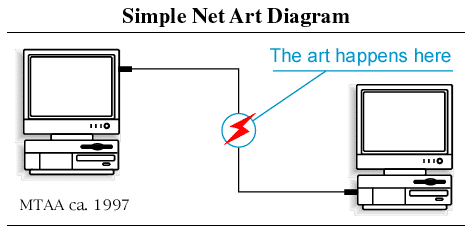Slightly edited from the original essay, as first published under the title “The game happens in the middle” in LegendaryPKMN.net on January 1st 2018.
Media theory is a field of theories on the intersection of philosophy and many other disciplines that study aspects of society and culture. The word media originates in the Latin medius meaning “intermediate” or the “middle”. What is in the middle, is what goes unnoticed for it is traditionally considered an unremarkable channel; something which only conveys; a “series of tubes”.

Media theorist Marshall McLuhan claimed that all human technologies are media. His well-known quote “The medium is the message.” is an insight to his belief that the way someone receives information is more important than the information in itself.
Contemporary art exists in the in-between of the artist’s work and the observer, realized solely through the interaction of people. The interaction of the observer with the artwork, or between multiple observers and the artwork, is a common aspect in contemporary art practices in the field of new media arts. To be fair, most contemporary art forms invite participation and assume a role in the social exchange between the observers / actors. Another way to put it, is that contemporary art exists in the in-between of the artist’s work and the observer, realized solely through the interaction of people. Art isn’t a concept beyond the realm of humans but a product of our culture, a result of our needs and or the technological means it occupies.
A parallel to how we perceive art is illustrated in an iconic GIF animation from the realm of Net Art. In Simple Net Art Diagram (1997) the artistic duo MTAA exhibit where art happens on the net: not on the surface of screens, but in the middle.

It is thus, whatever happens in the middle that matters, as is how it happens. The information contemporary works of art convey is less important than the self-reflection they provoke. Likewise, contemporary video games expand their boundaries over the confines of the cartridge or any digital format.
Art made online exists solely if realized by both author and viewer, since an experience of the work is possible only once, or if, it is accessed.
— via Rhizome
Coincidentally, in 1996 a newborn video game series had just introduced its social mechanic in a short animation experienced by over 46 million young game players. That number is certainly far greater than the crowd familiar with Simple Net Art Diagram though arguably its audience is much less perceptive of the importance of it. Employing the myth of Narcissus, McLuhan pointed to the fixations early in the life cycle of every new technology. As video game players, we may be unaware of the social structures we participate, similar to how the “gadget lover” Narcissus was fascinated with his reflection.

The Pokémon trade mechanic, is the process in which a player or “trainer”, sends one of his or her Pokémon to another trainer in exchange for a Pokémon of their own. Not only is this mechanic encouraged, but necessary to collect all Pokémon characters. The creative mind behind the Pokémon games, game designer Satoshi Tajiri, was reportedly inspired by the joining of two Game Boy consoles with a link cable, then turned his childhood hobby of trading insects into the core social mechanic of the games. Each “generation” of Pokémon video games, comes in two versions, with slight differences on the availability of creatures within, to futher support the trade mechanic. Satoshi Tajiri managed to transform a childhood hobby and the traces of the 16th century Japanese tradition of spider battles, in a vehicle of socialization for a whole generation of kids.
In pop-culture slang, we’d say that many contemporary artworks are meta, a term that is often understood to describe something referring to itself. When talking about video games, meta or the unabbreviated term meta-game may mean either: 1) the “bending” of the game world rules with techniques (or tech) that may have not been predicted by its creators and the formation of strategies upon these techniques or 2) the universe of things outside the game itself.
[…] the concept of media has become completely identical with interfaces and digital objects that can be manipulated on the screen
— Bernhard Siegert (via Not Art&Tech)
The universe of any game includes both the original work, and the bottom-up fan communities, the rich interactions occurring within. Enthusiastic audiences, sharing feelings of companionship and devotion to the works in question, participate in a discourse and create meta-works, derivatives and remixes inseparable from it.
The trade mechanic in the Pokémon series and the Game Link accessory were not designed to technically transmit data between two Game Boys, but to become a channel of social interaction. Established on the same principle, the recent example Pokémon GO’s raid system has finally managed to replicate the community building mechanism of the franchise.

Game Link Cable for the Game Boy. By Evan Amos on Wikipedia.
It should be noted that this is no privilege of the Pokémon franchise per se. There are analogous mechanisms in many games, many of them feature much more massive and opinionated online communities. With the exception of e-Sport friendly games, there are not many that manage to blend so seamlessly into the tangible world. Again, that may not be a privilege of a single franchise, but an effect of portable consoles, an enabler of social gaming Nintendo has traditionally built upon, from the era-defining Game Boy to the friends & family oriented Nintendo Wii and eventually the hybrid Nintendo Switch.
Consoles and video games in general are not designed as gadgets purposed to lead the individual to isolation, but to spark joy and excitement. If successful in their purpose, they are a unique catalyst for meaningful interpersonal interactions. Hence, they also ought not to be examined in isolation, but in the context of the communal experiences they enable.
Vocal opponents of video games tend to forget one thing: we are dependent on others, and dependent on participating in the cultural experiences that define our shared memories. But people from within the industry also neglect this aspect. When game critics judge the hardware’s technical proficiency or the games’ aesthetic merits, purposeful gameplay and coherence of story, they may also need to consider the potential they have in encouraging experiences beside the screens.